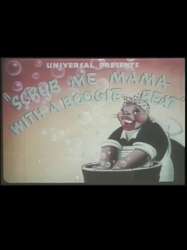Walter Lantz is a Actor, Director, Story, Producer, Title Designer and Animation American born on 27 april 1899 at New Rochelle (USA)

Walter Benjamin Lantz (April 27, 1899 – March 22, 1994) was an American cartoonist, animator, film producer, and director, best known for founding Walter Lantz Productions and creating Woody Woodpecker.
Lantz was born in New Rochelle, New York to Italian immigrant parents, Francesco Paolo Lantz (formerly Lanza) and Maria Gervasi from Calitri. According to Joe Adamson's biography, The Walter Lantz Story, Lantz's father was given his new surname by an immigration official who Anglicized it. Walter Lantz was always interested in art, completing a mail order drawing class at age twelve. He was inspired when he saw Winsor McCay's animated short, Gertie the Dinosaur.
While working as an auto mechanic Lantz got his first break. A wealthy customer named Fred Kafka liked his drawings on the garage's bulletin board and financed Lantz's studies at the Art Students League of New York. Kafka also helped him land a job as a copy boy at the New York American, owned by William Randolph Hearst. Lantz worked at the newspaper and attended art school at night.
By the age of 16, Lantz was working in the animation department under director Gregory La Cava. Lantz then worked at the John R. Bray Studios on the Jerry On The Job series. In 1924, Lantz directed, animated, and even starred in his first cartoon series, Dinky Doodle, and soon replaced George "Vernon" Stallings as head of production (In the 1920s, Bray began to concentrate on competing with Hal Roach, the "king of two-reelers"). Lantz moved to Hollywood, California after Bray switched to a publicity film studio in 1927, where he worked briefly for director Frank Capra and was a gag writer for Mack Sennett comedies.
The Oswald era
In 1928, Lantz was hired by Charles B. Mintz as director on the Oswald the Lucky Rabbit cartoon series for Universal Studios. Earlier that year, Mintz and his brother-in-law George Winkler had succeeded in snatching Oswald from the character's creator, Walt Disney. Universal president Carl Laemmle grew dissatisfied with the Mintz-Winkler product and fired them, deciding instead to produce the Oswalds on the Universal lot. While schmoozing with Laemmle, Lantz wagered that if he could beat Laemmle in a game of poker, the character would be his. As fate would have it, Lantz won the bet, and Oswald was now his character.
Lantz inherited many of his initial staff, including animator Tom Palmer and musician Bert Fiske from the Winkler studio, but importantly he chose fellow New York animator, Bill Nolan, to help develop the series. Nolan's previous credentials included inventing the panorama background and developing a new, streamlined Felix the Cat. Nolan was (and still is) probably best known for perfecting the "rubber hose" style of animation. In September 1929, Lantz released his first cartoon, Race Riot.
By 1935, Nolan parted company with Lantz. Lantz became an independent producer, supplying cartoons to Universal instead of merely overseeing the animation department. By 1940, he was negotiating ownership for the characters he had been working with.
The Woody Woodpecker era
When Oswald had worn out his welcome, Lantz needed a new character. Meany, Miny and Moe (three ne'er-do-well chimps), Baby-Face Mouse, Snuffy Skunk, Doxie (a comic dachshund) and Jock and Jill (monkeys that resembled Warner Brothers' Bosko) were some personalities Lantz and his staff came up with. However, one character, Andy Panda, stood out and soon became Lantz's headline star for the 1939-1940 production season.
In 1940, Lantz married actress Grace Stafford. During their honeymoon, the couple kept hearing a woodpecker incessantly pecking on their roof. Grace suggested that Walter use the bird for inspiration as a cartoon character. Taking her advice, though a bit skeptical, Lantz debuted Woody Woodpecker in an Andy Panda short, Knock Knock. The brash woodpecker character was similar to the early Daffy Duck, and Lantz liked the results enough to build a series around it.
Mel Blanc supplied Woody's voice for the first three cartoons. When Blanc accepted a full-time contract with Leon Schlesinger Productions/Warner Bros. and left the Lantz studio, gagman Ben Hardaway, the man who was the main force behind Knock Knock, became the bird's voice. Despite this, Blanc's distinctive laugh was used throughout the cartoons.
During 1948, the Lantz studio created a hit Academy Award-nominated tune in "The Woody Woodpecker Song", featuring Blanc's laugh. Mel Blanc sued Lantz for half a million dollars, claiming that Lantz had used his voice in later cartoons without permission. The judge, however, ruled for Lantz, saying that Blanc had failed to copyright his voice or his contributions. Though Lantz won the case, he paid Blanc in an out-of-court settlement when Blanc filed an appeal, and Lantz went in search for a new voice for Woody Woodpecker.
In 1950, Lantz held anonymous auditions. Grace, Lantz's wife, offered to do Woody's voice; however, Lantz turned her down because Woody was a male character. Not discouraged in the least, Grace made her own anonymous audition tape, and submitted for the studio to listen to. Not knowing who was behind voice he heard, Lantz picked Grace's voice for Woody Woodpecker. Grace supplied Woody's voice until the end of production in 1972, and also performed in non-Woody cartoons. At first, Grace voiced Woody without screen credit, thinking that it would disappoint child viewers to that know Woody Woodpecker was voiced by a woman. However, she soon came to enjoy being known as the voice of Woody Woodpecker, and allowed her name to be credited on the screen. Her version of Woody was cuter and friendlier than the manic Woody of the 1940s, and Lantz's artists redesigned the character to suit the new personality.
Lantz's harmonious relationship with Universal, the studio releasing his cartoons, was jarred when new ownership transformed the company into Universal-International and did away with many of Universal's company policies. The new management insisted on owning licensing and merchandising rights to Lantz's characters. Lantz refused and withdrew from the parent company by the end of 1947, releasing 12 cartoons independently through United Artists in 1948, into the beginning of 1949. Financial difficulties forced Lantz to shut down his studio in 1949. Universal-International re-released Lantz's UA (and several earlier) cartoons during the shutdown and eventually came to terms with Lantz, who resumed production in 1951. From this point forward, Lantz worked faster and cheaper, no longer using the lush, artistic backgrounds and stylings that had distinguished his 1940s work.
Lantz used his TV appearances on The Woody Woodpecker Show (which began in 1957) to demonstrate the animation process. Later, Lantz entertained the troops during the Vietnam War and visited hospitalized veterans. Walter Lantz was a good friend of movie innovator George Pal.
Retirement
By the 1960s other movie studios had discontinued their animation departments, leaving Walter Lantz as one of two producers still making cartoons for theaters (the other studio was DePatie-Freleng Enterprises). Lantz finally closed up shop in 1972 (by then, explained, it was economically impossible to continue producing them and stay in business as rising inflation had strained his profits), and Universal serviced the remaining demand with reissues of his older cartoons.
In retirement, Lantz continued to manage his properties by licensing them to media. He continued to draw and paint, selling his paintings of Woody Woodpecker rapidly. On top of that, he worked with Little League and other youth groups in his area. In 1982, Lantz donated 17 artifacts to the Smithsonian Institution's National Museum of American History, among them a wooden model of Woody Woodpecker from the cartoon character’s debut in 1941. The Lantzes also made time to visit hospitals and other institutions where Walter would draw Woody and Grace would do the Woody laugh for patients.
In 1990 "Woody Woodpecker" was honored with a star on the Hollywood "Walk Of Fame". In 1993, Lantz established a ten thousand dollar scholarship and prize for animators in his name at California Institute of the Arts in Valencia. Walter Lantz died at St. Joseph Medical Center in Burbank, California from heart failure on March 22, 1994, aged 94.
Source : Wikidata
Walter Lantz

- Infos
- Photos
- Best films
- Family
- Characters
- Awards
Birth name Walter Benjamin Lantz
Nationality USA
Birth 27 april 1899 at New Rochelle (USA)
Death 22 march 1994 (at 94 years) at Burbank (USA)
Awards Annie Award
Nationality USA
Birth 27 april 1899 at New Rochelle (USA)
Death 22 march 1994 (at 94 years) at Burbank (USA)
Awards Annie Award
Biography
Early years and start in animationLantz was born in New Rochelle, New York to Italian immigrant parents, Francesco Paolo Lantz (formerly Lanza) and Maria Gervasi from Calitri. According to Joe Adamson's biography, The Walter Lantz Story, Lantz's father was given his new surname by an immigration official who Anglicized it. Walter Lantz was always interested in art, completing a mail order drawing class at age twelve. He was inspired when he saw Winsor McCay's animated short, Gertie the Dinosaur.
While working as an auto mechanic Lantz got his first break. A wealthy customer named Fred Kafka liked his drawings on the garage's bulletin board and financed Lantz's studies at the Art Students League of New York. Kafka also helped him land a job as a copy boy at the New York American, owned by William Randolph Hearst. Lantz worked at the newspaper and attended art school at night.
By the age of 16, Lantz was working in the animation department under director Gregory La Cava. Lantz then worked at the John R. Bray Studios on the Jerry On The Job series. In 1924, Lantz directed, animated, and even starred in his first cartoon series, Dinky Doodle, and soon replaced George "Vernon" Stallings as head of production (In the 1920s, Bray began to concentrate on competing with Hal Roach, the "king of two-reelers"). Lantz moved to Hollywood, California after Bray switched to a publicity film studio in 1927, where he worked briefly for director Frank Capra and was a gag writer for Mack Sennett comedies.
The Oswald era
In 1928, Lantz was hired by Charles B. Mintz as director on the Oswald the Lucky Rabbit cartoon series for Universal Studios. Earlier that year, Mintz and his brother-in-law George Winkler had succeeded in snatching Oswald from the character's creator, Walt Disney. Universal president Carl Laemmle grew dissatisfied with the Mintz-Winkler product and fired them, deciding instead to produce the Oswalds on the Universal lot. While schmoozing with Laemmle, Lantz wagered that if he could beat Laemmle in a game of poker, the character would be his. As fate would have it, Lantz won the bet, and Oswald was now his character.
Lantz inherited many of his initial staff, including animator Tom Palmer and musician Bert Fiske from the Winkler studio, but importantly he chose fellow New York animator, Bill Nolan, to help develop the series. Nolan's previous credentials included inventing the panorama background and developing a new, streamlined Felix the Cat. Nolan was (and still is) probably best known for perfecting the "rubber hose" style of animation. In September 1929, Lantz released his first cartoon, Race Riot.
By 1935, Nolan parted company with Lantz. Lantz became an independent producer, supplying cartoons to Universal instead of merely overseeing the animation department. By 1940, he was negotiating ownership for the characters he had been working with.
The Woody Woodpecker era
When Oswald had worn out his welcome, Lantz needed a new character. Meany, Miny and Moe (three ne'er-do-well chimps), Baby-Face Mouse, Snuffy Skunk, Doxie (a comic dachshund) and Jock and Jill (monkeys that resembled Warner Brothers' Bosko) were some personalities Lantz and his staff came up with. However, one character, Andy Panda, stood out and soon became Lantz's headline star for the 1939-1940 production season.
In 1940, Lantz married actress Grace Stafford. During their honeymoon, the couple kept hearing a woodpecker incessantly pecking on their roof. Grace suggested that Walter use the bird for inspiration as a cartoon character. Taking her advice, though a bit skeptical, Lantz debuted Woody Woodpecker in an Andy Panda short, Knock Knock. The brash woodpecker character was similar to the early Daffy Duck, and Lantz liked the results enough to build a series around it.
Mel Blanc supplied Woody's voice for the first three cartoons. When Blanc accepted a full-time contract with Leon Schlesinger Productions/Warner Bros. and left the Lantz studio, gagman Ben Hardaway, the man who was the main force behind Knock Knock, became the bird's voice. Despite this, Blanc's distinctive laugh was used throughout the cartoons.
During 1948, the Lantz studio created a hit Academy Award-nominated tune in "The Woody Woodpecker Song", featuring Blanc's laugh. Mel Blanc sued Lantz for half a million dollars, claiming that Lantz had used his voice in later cartoons without permission. The judge, however, ruled for Lantz, saying that Blanc had failed to copyright his voice or his contributions. Though Lantz won the case, he paid Blanc in an out-of-court settlement when Blanc filed an appeal, and Lantz went in search for a new voice for Woody Woodpecker.
In 1950, Lantz held anonymous auditions. Grace, Lantz's wife, offered to do Woody's voice; however, Lantz turned her down because Woody was a male character. Not discouraged in the least, Grace made her own anonymous audition tape, and submitted for the studio to listen to. Not knowing who was behind voice he heard, Lantz picked Grace's voice for Woody Woodpecker. Grace supplied Woody's voice until the end of production in 1972, and also performed in non-Woody cartoons. At first, Grace voiced Woody without screen credit, thinking that it would disappoint child viewers to that know Woody Woodpecker was voiced by a woman. However, she soon came to enjoy being known as the voice of Woody Woodpecker, and allowed her name to be credited on the screen. Her version of Woody was cuter and friendlier than the manic Woody of the 1940s, and Lantz's artists redesigned the character to suit the new personality.
Lantz's harmonious relationship with Universal, the studio releasing his cartoons, was jarred when new ownership transformed the company into Universal-International and did away with many of Universal's company policies. The new management insisted on owning licensing and merchandising rights to Lantz's characters. Lantz refused and withdrew from the parent company by the end of 1947, releasing 12 cartoons independently through United Artists in 1948, into the beginning of 1949. Financial difficulties forced Lantz to shut down his studio in 1949. Universal-International re-released Lantz's UA (and several earlier) cartoons during the shutdown and eventually came to terms with Lantz, who resumed production in 1951. From this point forward, Lantz worked faster and cheaper, no longer using the lush, artistic backgrounds and stylings that had distinguished his 1940s work.
Lantz used his TV appearances on The Woody Woodpecker Show (which began in 1957) to demonstrate the animation process. Later, Lantz entertained the troops during the Vietnam War and visited hospitalized veterans. Walter Lantz was a good friend of movie innovator George Pal.
Retirement
By the 1960s other movie studios had discontinued their animation departments, leaving Walter Lantz as one of two producers still making cartoons for theaters (the other studio was DePatie-Freleng Enterprises). Lantz finally closed up shop in 1972 (by then, explained, it was economically impossible to continue producing them and stay in business as rising inflation had strained his profits), and Universal serviced the remaining demand with reissues of his older cartoons.
In retirement, Lantz continued to manage his properties by licensing them to media. He continued to draw and paint, selling his paintings of Woody Woodpecker rapidly. On top of that, he worked with Little League and other youth groups in his area. In 1982, Lantz donated 17 artifacts to the Smithsonian Institution's National Museum of American History, among them a wooden model of Woody Woodpecker from the cartoon character’s debut in 1941. The Lantzes also made time to visit hospitals and other institutions where Walter would draw Woody and Grace would do the Woody laugh for patients.
In 1990 "Woody Woodpecker" was honored with a star on the Hollywood "Walk Of Fame". In 1993, Lantz established a ten thousand dollar scholarship and prize for animators in his name at California Institute of the Arts in Valencia. Walter Lantz died at St. Joseph Medical Center in Burbank, California from heart failure on March 22, 1994, aged 94.
Best films
Usually with
Filmography of Walter Lantz (28 films)
Actor
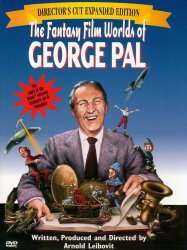 , 1h33
, 1h33Directed by Arnold Leibovit
Origin USA
Genres Documentary
Themes Documentary films about business, Documentary films about the visual arts, Documentary films about the film industry, Documentaire sur une personnalité
Actors George Pal, Robert Bloch, Chesley Bonestell, Ray Bradbury, Tony Curtis, Joe Dante
Rating72%





Director

Woody Woodpecker (1941)
, 7minutesDirected by Walter Lantz
Origin USA
Genres Comedy, Animation
Actors Mel Blanc, Sara Berner
Rating71%





Woody Woodpecker passe sa journée à chanter fort et à faire des trous dans les arbres. Il exaspère les autres créatures des bois - quand il ne les déconcerte pas avec son comportement bizarre. Woody entend un écureuil et un groupe d’oiseaux bavarder à son sujet. Même s’il vient de chanter une chanson proclamant sa folie, il nie leurs accusations chuchotées qu’il est fou. Mais après qu’ils l’ont piégé en lui frappant la tête sur une statue, le pauvre oiseau entend des voix dans sa tête et décide que les animaux pourraient avoir raison. Il décide de voir un médecin.

Pantry Panic (1941)
, 7minutesDirected by Walter Lantz
Origin USA
Genres Animation
Actors Mel Blanc, Ben Hardaway, Kent Rogers, Sara Berner
Rating66%





Le Professeur Weatherby Groundhog, une marmotte, sort en trombe de son terrier pour placarder un avis de vague de grand froid et sonner le tocsin (en perdant par moments sa culotte). Aussitôt, les oiseaux (habillés et agissant comme des humains) sortent de leurs nids en forme de maisons et accourent devant l'affiche. Elle recommande à ceux-ci de partir au plus vite et d'émigrer vers le sud. C'est la panique ! Chacun va chercher ses affaires et tous quittent rapidement la région : un couple barricade la maison, un oiseau rentre la sienne dans un trou d'arbre et tire une fermeture-éclair pour refermer le trou. Une famille entière se précipite dehors en se tenant chacun la main (y compris le grillon du foyer), elle est suivie du poussin qui vient tout juste d'éclore de son œuf.
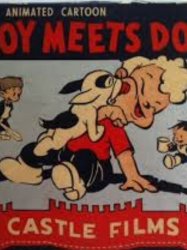
Boy Meets Dog (1938)
, 9minutesDirected by Walter Lantz
Genres Comedy, Animation
Themes Films about animals, Films about dogs
Actors Billy Bletcher
Rating58%





A boy, Bobby, gets a lesson in school about how to properly massage his gums to take care of his teeth. After class is dismissed, Bobby is offered by his friends in to an ice cream shop to have a sundae and go fishing. Bobby refuses saying, "My father won't let me." On the way home, Bobby finds a beagle and takes him home. They sneak into the house where Bobby cleans him up in order to convince his father to keep him. Bobby's father scares the dog away and the dog hides in the house. Muttering about his son, he steps on a rollerskate and falls down the stairs. He walks back upstairs to Bobby's room to punish him, but Bobby is not there and he begins looking for him. The gnomes and elves on the wallpaper in Bobby's room come alive and knock Bobby's father unconscious and take him into the forest scene in the wallpaper.

The Candy House (1934)
Directed by Walter Lantz
Genres Animation
Themes Films about families, Buddy films, Children's films
Rating57%





Hansel (Oswald the Lucky Rabbit) and Gretel are two simple children who live with their father and stepmother. Although they have little resources, they are happy. One day the stepmother is irritated by the food shortage, and makes the children go to bed without dinner. The stepmother then talks to the father about taking the children deep in the forest to be abandoned. The father is too timid to argue. Hansel and Gretel overhear their conversation.
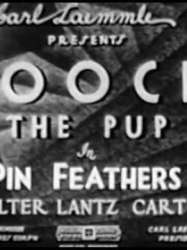
Pin Feathers (1933)
Directed by Walter Lantz
Genres Animation
Themes Films about animals, Films about dogs
Pooch is walking around in the forest. Though he whistles sometimes, he does not have any lines in this film. On his way, he encounters a young featherless bird that is trying to get a worm. But the worm suddenly reverses direction and swallows the bird. Pooch, who is sympathetic for the little fowl, extracts the bird from within the worm.

Carnival Capers (1932)
Directed by Bill Nolan, Walter Lantz
Genres Animation
Themes Transport films, Road movies, Children's films, Chase films
Rating62%





Oswald and the girl beagle (making her debut in this film) are at the fair, dancing on a wooden platform. All of a sudden, a large oppressive pit bull pulls it right under their feet, much to their surprise. The pit bull pretends to apologize in giving Oswald a handshake but snaps a rat trap at the rabbit's hand instead. When the large dog flirts with the girl beagle, the annoyed Oswald quickly takes her and walks out of the scene.

Teacher's Pests (1932)
Directed by Bill Nolan, Walter Lantz
Genres Animation
Themes Children's films
Rating74%





A female buffalo who is a school teacher is attending a class. While she conducts as most of the students are singing, the boy beagle (making his debut in this film) blows his nose, much to her disturbance. When the buffalo tells the boy beagle to approach, another student puts a balloon under his very long shirt. And as she strikes the little dog in the rear with a rod, the balloon bursts, creating a loud noise. The buffalo then tells the boy beagle to just stand next to the extra chalk board.

The Athlete (1932)
Directed by Bill Nolan, Walter Lantz
Genres Animation
Themes Films about animals, Films about dogs
Rating55%





Pooch is a participant in a number of track and field events. His first event is a sprinting competition. Because of poor signaling from the signal man, Pooch runs but the other competitors remain in their starting position. Pooch reaches the finish line but fails to come across as the tape slings him back to the starting line. The signal man restarts the race, and this time all the runners make their move. Pooch again reaches the finish line but again gets sling back by the tape. His second flight also causes him to push back the other runners. Pooch resumes his run and wins the race, thanks to the absence of the tape at the end of the track.

Cats and Dogs (1932)
Directed by Walter Lantz
Genres Animation
Themes Films about animals, Sports films, American football films, Films about dogs
Rating57%





Pooch is a football player who leads a team of dogs. They take on a team which is composed of cats.
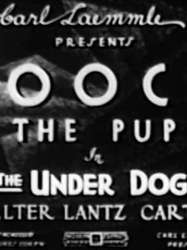
The Under Dog (1932)
Directed by Bill Nolan, Walter Lantz
Genres Animation
Themes Films about animals, Films about dogs
Rating73%





Pooch (now wearing shoes and a hat) is a penniless vagabond wondering the countryside, and carrying a sack on the end of a stick. On his way, he comes across his sweetheart the girl coonhound (now having lighter fur) who is milking a cow. After they greet each other, Pooch sings the song A Great Big Bunch of You. Moments later, an old dog, who is the girl coonhound's employer, shows up and isn't happy to see him. The old dog hurls Pooch past the fences bordering the farmlands where he lands next to a sign saying "No tramps allowed."

The Bandmaster (1931)
Directed by Bill Nolan, Walter Lantz
Genres Animation
Themes Films about music and musicians, Musical films, Children's films
Rating59%





On the street, Oswald leads a handful of musicians whose devotedness towards him varies. Although the performance of the band showed some flaws, it mattered little to Oswald who simply carries on. Suddenly, the musicians decided to have a break inside the tavern, much to the rabbit's surprise. Oswald tries to follow them to the place, only to be pushed back out.

The Clown (1931)
Directed by Bill Nolan, Walter Lantz
Genres Animation
Themes Circus films, Children's films
Rating50%





Oswald, as the title implies, is a circus clown who performs acts in the big top along with his partner the live female stuffed doll. After doing some acts involving horses, the doll is being asked by the ringmaster to sign some kind of contract. Oswald is suspicious of the ringmaster's plans, and tries to intervene, only to be whipped away by the ringmaster.
 Connection
Connection



